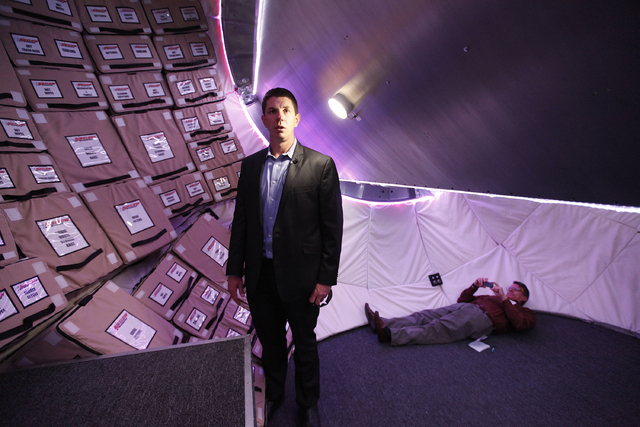.

Rick Fraker, an industrial designer at Boeing, takes a tour of a mockup of Bigelow Aerospace's BA-330 space module at Bigelow Aerospace in North Las Vegas Wednesday, April 30, 2014.
.
Man’s return to the moon and space travel to Mars may go through North Las Vegas.
Representatives of Bigelow Aerospace and aircraft designer Boeing, partners in the development of the next generation of space vehicles, on Wednesday unveiled models of the vehicles they hope will someday be used for those missions.
Boeing offered a first look at the interior of its reusable CST-100 space capsule designed to transport travelers to space stations in low-Earth orbit. The company will learn in August whether its crew space transportation system proposal will be funded by NASA for its commercial crew design module that would be used for transports to the International Space Station and to privately developed space stations like Bigelow’s BA-330.
Bigelow officials unveiled a full-scale model and gave tours of the BA-330, a space habitat that would be launched in a compact form and expanded to a work space of 330 cubic meters.
Boeing has conducted splash tests on the CST-100 at the Bigelow plant and impact tests in the Nevada desert.
Many of the same design engineers who developed the interiors of Boeing’s commercial aircraft are involved in CST-100 project.
“We are moving into a truly commercial space market and we have to consider our potential customers, beyond NASA, and what they need in a future commercial spacecraft interior,” said Chris Ferguson, who commanded one of last Atlantis shuttle missions and is now Boeing’s director of crew and mission operations for the commercial crew program.
Boeing has designed a space capsule capable of carrying up to nine passengers and a pilot into low-Earth-orbit. Boeing is considered one of the top competitors in the bid to develop a commercial spacecraft along with Sierra Nevada Space Corporation Space Systems of Louisville, Colo., and Space Explorations Technologies Corporation, or SpaceX, of Hawthorne, Calif.
The three competitors will learn in August which system will receive additional funding. It’s possible that two or all three may be funded, depending on budget limitations and on whether NASA wants to fund a backup plan. Boeing already has received more than $600 million in grants for research and development of a system to replace the space shuttle.
Currently, Russia handles transport to the International Space Station and it costs roughly $70 million a seat to ride.
NASA issued a challenge to private space travel companies to develop systems that would be competitive. Boeing says a ride on its CST-100 to the space station would cost about $30 million.
Meanwhile, Bigelow Aerospace is continuing its efforts to develop a versatile space station model that is expected to be tested next year and ready to launch in 2017.
Bigelow has long marketed its inflatable space station to foreign countries, scientific organizations and specialized manufacturers for the opportunity to work in space. The company is in the last stages of proving its concept and would custom build an interior to accommodate a paying customer.
Jay Ingham, vice president of manufacturing and assembly for Bigelow, said customers would include countries that want to send their scientists to space without having to develop an entire space travel infrastructure. Scientists and manufacturers also have expressed interest in using a space station for specialized research in zero-gravity conditions.
Eventually, an orbiting space station could be a space tourism destination, but for now, Bigelow is focused on scientific missions.
Ingham said Bigelow already has signed memoranda of understanding with seven prospective customers.
Next year, Bigelow will test its Bigelow Expandable Activity Module, or BEAM, which is about the size of a Volkswagen Beetle, on a planned launch to the International Space Station for a series of system tests.
If all goes as planned, the company would put the full-scale BA-330 in orbit two years later.
The BA-330 modules are designed to be coupled together like Legos. Several modules could be tied together to form a station and each has docking stations compatible with systems being used by prospective transport companies.
In the short term, Bigelow would sell or lease work space on their space stations. But eventually, modules could have propulsion systems attached to them for lunar or interplanetary space travel. NASA is studying the effects of space travel on humans on long space voyages. A trip to Mars, for example, would take six months with a return trip taking three times as long.
The inflatable space station would be equipped for soft landings on the moon or Mars where it would become living space.
The full-scale BA-330 is a cylinder about three stories tall with storage space and netting along the walls and work spaces along the central core.
About 130 people work at the Bigelow facility in North Las Vegas.
.

Jay Ingham, vice president of manufacturing and assembly at Bigelow Aerospace, gives a tour of a mockup of the company's BA-330 space module at the company in North Las Vegas Wednesday, April 30, 2014
.
Quelle: Las Vegas Review-Journal
